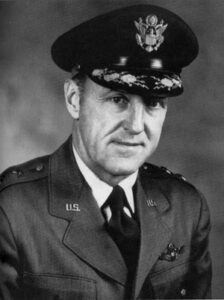19 June 1947 – Col Albert Boyd sets a new official world airspeed record of 623.62 mph (1,003 km/h) in a Lockheed P-80 Shooting Star. (This is still marginally slower than unofficial German speed records in rocket-powered aircraft during World War II). “This was the first U.S. jet world speed record and was the first time in 24 years that the U.S. had held the world speed record.”(2)
 Albert G Boyd (November 22, 1906 – September 18, 1976) was a pioneering test pilot for the United States Air Force (USAF). During his 30-year career, he logged more than 23,000 hours of flight time in 723 military aircraft (though this number of the total number flown includes variants and sub-variants of some types, and is not 723 distinct types). When he retired in 1957, he had flown every aircraft type operated by the USAF, including attack, cargo, trainer, fighter, experimental, bomber, mission trainer, liaison, observation, and general aviation planes and helicopters.
Albert G Boyd (November 22, 1906 – September 18, 1976) was a pioneering test pilot for the United States Air Force (USAF). During his 30-year career, he logged more than 23,000 hours of flight time in 723 military aircraft (though this number of the total number flown includes variants and sub-variants of some types, and is not 723 distinct types). When he retired in 1957, he had flown every aircraft type operated by the USAF, including attack, cargo, trainer, fighter, experimental, bomber, mission trainer, liaison, observation, and general aviation planes and helicopters.
From 1947 to 1957, Boyd flew and approved every aircraft type acquired by the USAF. When he retired, he was praised as the “Father of Modern Flight Testing,” “World’s Number One Test Pilot,” “Dean of American Test Pilots” and “Father of USAF Test Pilots.”
His assignments included:
Chief of Flight Section at Wright Patterson AFB
Commander, Experimental Test Pilot School
First Commander, USAF Flight Test Center at Edwards Air Force Base
Commander, Wright Air Development Center (Maj. Chuck Yeager, a test pilot in his command, was the first American pilot to test the MiG-15, associated with Operation Moolah.)
Deputy Commander, Weapons System Headquarters, Air Research and Development Command
Commanding General of Edwards AFB
The prototype Lockheed P-80 Shooting Star, modified as a racer and designated P-80R, was piloted by Colonel Boyd to 623.73 mph (1,004.2 km/h) on 19 June 1947. This was recognized as an official airspeed record, although this speed had already been exceeded by the Me 163 and Me 262 in 1944.
Boyd led the newly-formed Air Force’s X-1 supersonic flight program and made the selection of Chuck Yeager to pilot the plane. Yeager described Boyd as a strict disciplinarian who would enforce (often with a very loud voice) USAF uniform regulations. He remarked that “You might be his star pilot, but Lord help you if you came before him in his office with an un-shined belt buckle”. Boyd was highly respected by his subordinates.
Boyd died on September 18, 1976. He and his wife Anna Lu (1907–1981) are buried at Arlington National Cemetery. (1)
Sources: Wikipedia, (1) NationalAviation.org
